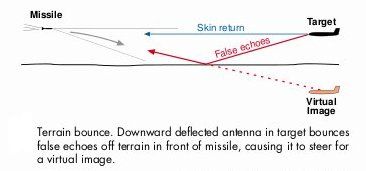I am glad you are familiar with 'variable depth sonar'. There are many other techniques to detect shallow water objects as well. Neither of these methods are as accurate as deep water tracking.
Whenever you make a declaration, especially in the technical realm, it would help the readers, and your credibility, to support your argument, like this...
Sonars don't work good in shallow waters.
This is assuming single/fixed point/location transmission.
We know that sound velocity profiles (SVP) are affected by many factors such as salinity, temperature, and pressure...
Sound Transmission in the Ocean - sea, depth, oceans, temperature, salt, system, wave, marine, salinity, Pacific
A temperature gradient exists when the temperature of the water decreases with increasing depth. The resulting thermocline shows a characteristic decrease in the speed of sound with decreasing temperature. However, at a depth of approximately 750 meters (2,460 feet), the variations in temperature become so slight that the water becomes essentially isothermal (of uniform temperature). From that point, the speed of sound is regulated more by changes in pressure that accompany the increasing depth.
Because sound wave transmission speed is directly proportional to pressure, the speed of sound increases as the pressure increases with depth.
Sonar Propagation in Statified Waters - March/April 2010, Volume 14, Number 2 - Archive - Hydro International
Salinity Profile
The acoustic environment in estuaries changes over very short scales. The salinity profile determines the halocline depth, the stratification and the form of the sound velocity profile and hence the coverage of any sonar system.
Some use sound speed (SSP) profile instead of 'velocity'...
Multibeam Systems - Sound Velocity Instruments
The sound speed profiles can be quite variable in the ocean due to factors such as fresh water run-off, daily heating and cooling cycles, upwelling and downwelling, etc. Accordingly, an accurate and timely sound speed profile is required to process the multibeam sonar data. Normally the ship must stop to take a sound speed profile. Since time is money, when performing surveys it is important to obtain the profile as quickly as possible. This usually means profiles are taken at speeds of 1 m/s or more. Even so, a deep 2000 m profile can take over an hour. To make matters worse the profile should be refreshed at least every 6 hours. In coastal waters the profile should be refreshed more frequently due to fast changing conditions. The result is a requirement to profile as fast as possible. Due to the 'Salinity Spiking' problems associated with profiling CTDs at high speed it is always better to use a direct measuring sound speed sensor rather than a CTD.
Coastal regions, estuaries, and river/sea connections have highly brackish water -- for example -- that can produce salinity stratifications that will produce diverse localized VSP that no standard sonar system can adequately compensate as explained by the above source when it demand that these profiles must be updated even by the hours.
This is why the US regularly conduct overt and covert profiling of the world's coastal regions to gather as much data over time as possible to create -- for each country that have sea access -- a 'meta-profile' of its sonar characteristics. The electronic warfare (EW) analogy is electromagnetic (EM) reconnaissance of a country based upon everything EM, from radars of military and civilian nature to daily television and radio transmissions.
There are also multi-paths propagation, same as radar detection, in shallow waters due to sea floor and those temperature/salinity layers...
Ghosting is a common problem in both radar and sonar detection because of multi-paths propagation.
So deep channel tracking is highly successful because of the constant SVP created by high pressure and fairly uniform salinity but only if a sub is in deep water.
A 'variable depth sonar' is essentially a sonar whose operating depth can be changed on demand to compensate for those layers that can hide a body. Intentionally or not.
Would you please elaborate more about the details of the system you are thinking of, so we can discuss more effectively.
Would you please specify:
1. Number of arrays? array shape?
2. Kerf, array spacing
3. Sound frequency
4. single pulse, multi-pulse, Doppler, back propagation, combined
5. focusing on transmit (# of focal points)
6. focusing on recieve (# of focal points)
No, I will not. There are many parallels between radar detection and sonar detection, especially in the data processing realm where they are practically identical and I do not have civilian experience in either. The military does not have exclusivity in using 'variable depth sonar' systems. There are many natural threats to civilian vessels that are hidden by those underwater characteristics that require the use of these systems to expose those natural threats and enhance marine safety.
What I normally do is bring to the discussions foundational principles that many interested lay readers do not know and ended up making baseless claims. You failed to bring up those foundational principles as how I demonstrated above. Then once a reader did his own research to verify my sources, those baseless claims usually disappeared. The reader is free to make up his own mind on whether the military applications of those foundation principles, as claimed by the military and/or manufacturer of said equipment, are credible or not. It is very difficult for anyone to dispute an operational capability -- as claimed -- once he understood the foundations of said capability. That is the way it should be without me crossing any infosec threshold.
(assuming there is no jamming,...
Sonar 'jamming', while technically is real, is practically and tactically dangerous. More so than with radar detection. If you do not know where and how radar and sonar detection are similar and diverge, at the theoretical level, then there is no need to discuss this further.
...and no IR sensor involved)
How is infrared applicable in sonar detection? I could be missing something here. Must be old age and memory loss.


















